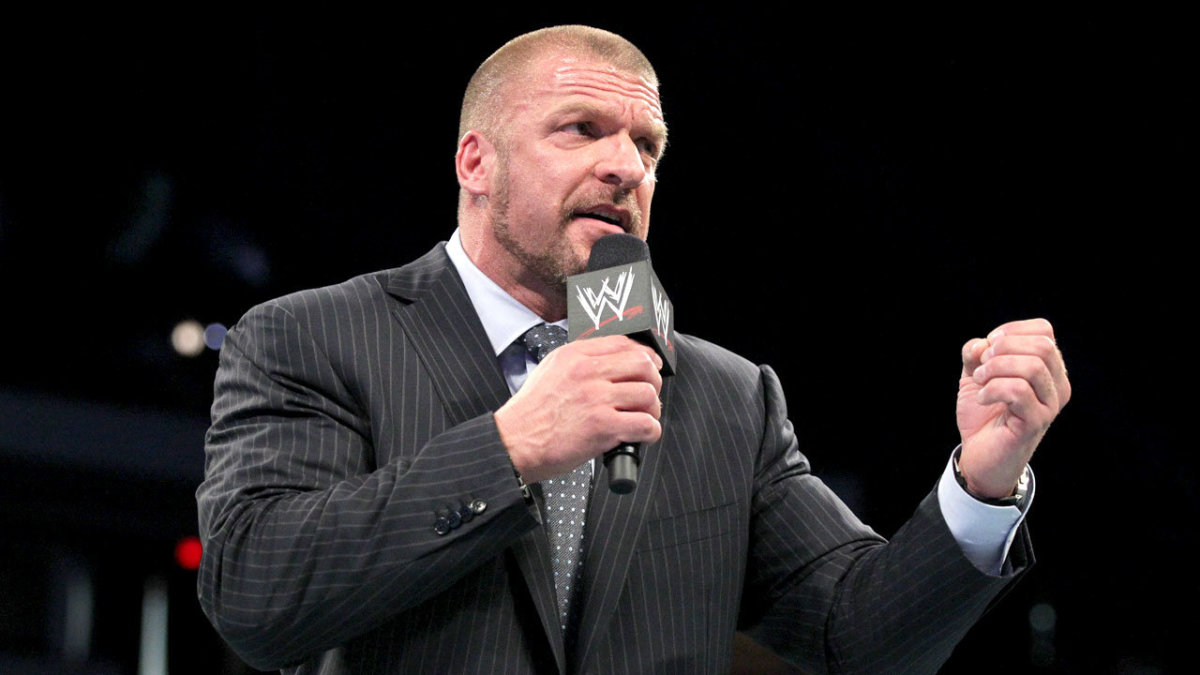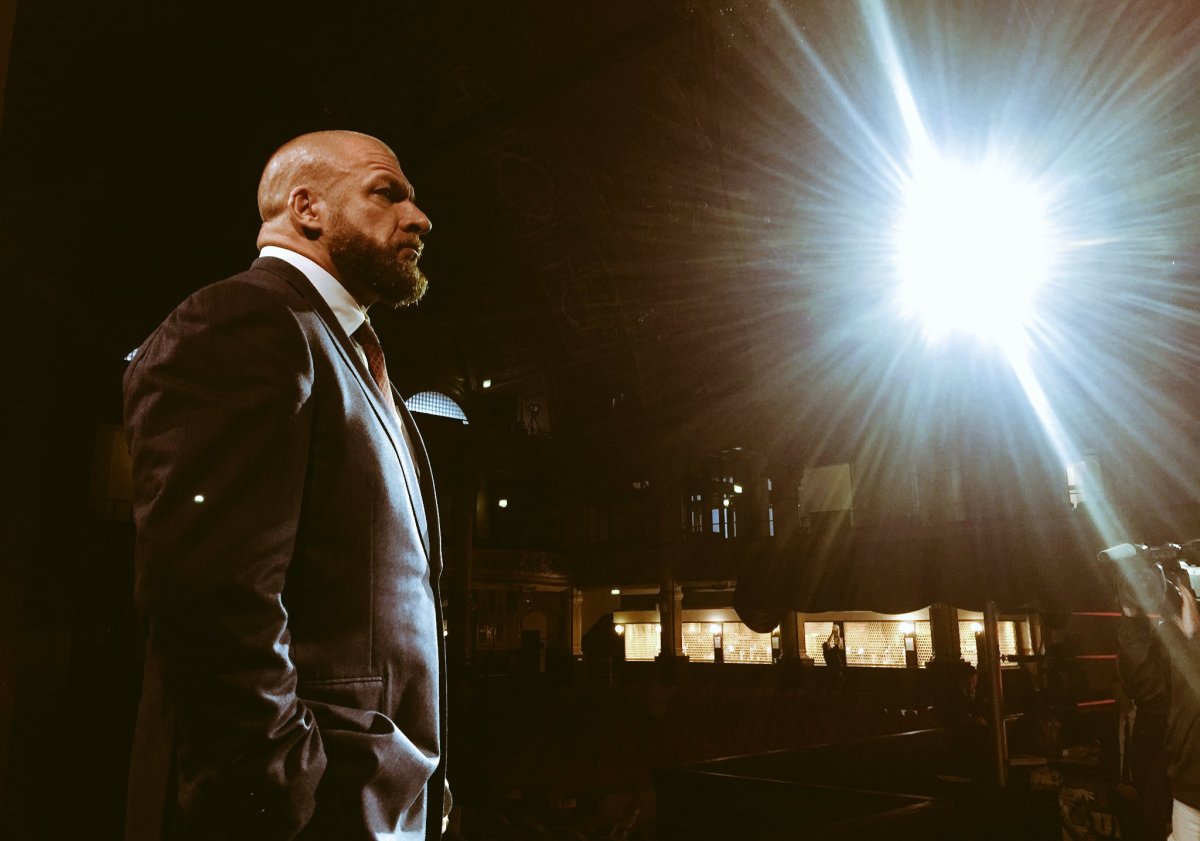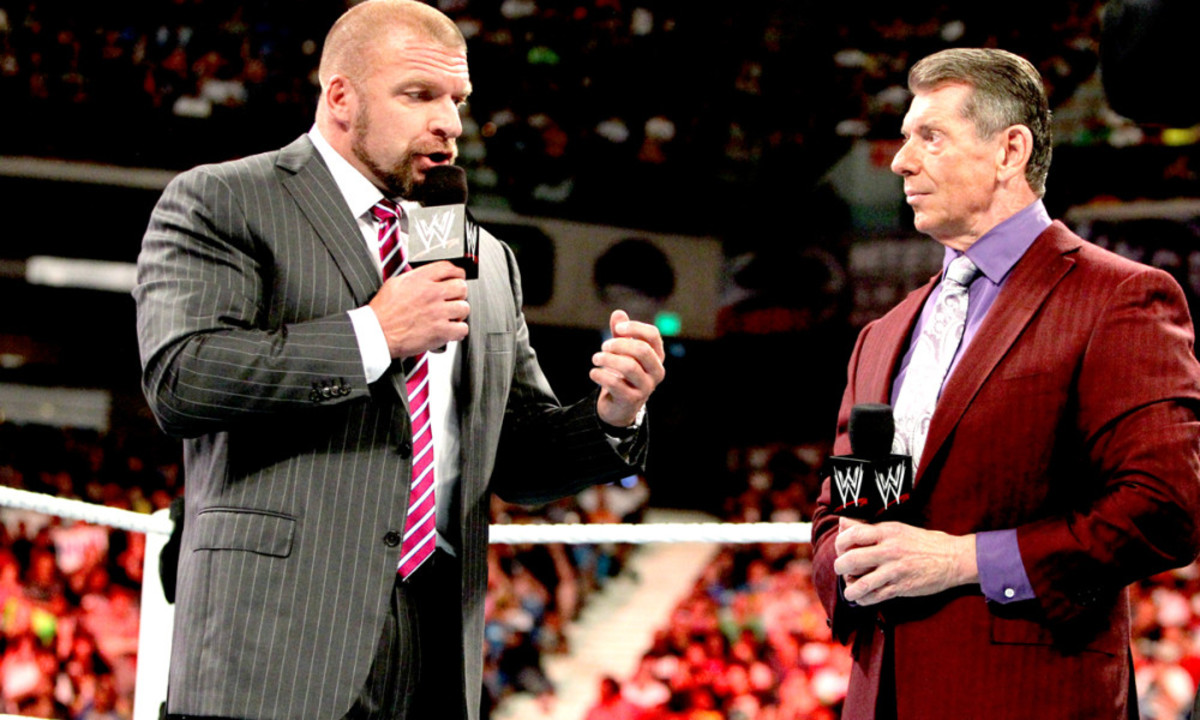How Paul Levesque used the lessons he learned as a wrestler to build WWE’s new brands

WWE has diversified its brand exponentially within the past three years with the Performance Center, NXT, the Cruiserweight Classic, the weekly 205 Live show, and the United Kingdom Championship Tournament to its own subscription-based video streaming service, the WWE Network.
As WrestleMania 33 approaches, Paul “Triple H” Levesque sat down with Sports Illustrated to discuss how the WWE builds brands, his indelible touch in the process, and the future of WWE.
Wrestling is championed by WWE as sports entertainment, which is a hybrid between professional sports and Shakespeare for the masses. The product contains enough raw athleticism that the problem of creativity also exists. Paul “Triple H” Levesque constantly asks himself and those around him for the best ways to create growth while still using the same canvas that existed a half-decade ago.
Levesque is helping WWE redefine its brand through projects like the Cruiserweight Classic, 205 Live show, and the United Kingdom Championship Tournament to provide global programming on a local basis.
“I do not see any of those projects as completed,” stated Levesque. “This is the first version of this Performance Center. There may be others, and this is the first version. NXT is what it is, but it’s gone from being the little developmental project to 200 live events a year to four pay per views a year. My goal is to make that must-see television so that you have to have the Network. My goal is to make 205 Live the place to see high-flying in a big way. If you’re a fan of the U.K. style, then the Network is the place to go get that style.”
Brian Kendrick is hungry to succeed on WWE’s new cruiserweight show
The story of Levesque, WWE, and the way in which the company builds its brands would, however, be incomplete without revisiting May 19, 1996.
WWE held a house show that Sunday at the famed Madison Square Garden in New York, and the main event concluded when fan favorite “The Heartbreak Kid” Shawn Michaels defeated arch-rival Diesel, which was the character portrayed by Kevin Nash. This marked the final WWE show for Nash and Scott Hall, as the pair had signed contracts with rival WCW, and Michaels wanted a proper send-off for his closest friends.
The Kliq—which consisted of Michaels, Nash, Hall, Levesque, and Sean “X-Pac” Waltman, who was injured and not present for that evening’s festivities—decided to embrace one another in the ring, capturing their genuine emotion for one another as well as expressing gratitude that they had been able to create such memorable moments on the WWE canvas.
Context is critical, and while breaking character—or kayfabe, as it is known in wrestling—is celebrated in 2017, it was forbidden in 1996. Vince McMahon was forced to respond to an act which some deemed sacrilege, and since Hall and Nash had left the company, and Michaels was the WWE champion, the only man left to take the hit was Levesque.
“The ‘Curtain Call’ became something more than it was in a moment in time,” explained Levesque. “Vince didn’t have a problem with it the second we walked out. By the next day, the problem was evident—it had created a mutiny.”
Levesque is now WWE’s Executive Vice President of Talent, Live Events, and Creative. Back in 1996, he began to question whether he would remain working for the company.
“I understand he had to punish,” said Levesque. “I understood the conversation I had with him. The only thing I said back to him was, ‘I have to know, at the end of this, that this is over. If there is no light at the end of the tunnel, I can’t do my job and I can’t be here. I don’t want to leave, I want to be here forever. But if there’s no light at the end of the tunnel, then what’s the point? But if it’s over, then give me whatever punishment you have to give me. As long as I know there is an end to it, I am confident enough in myself that I can get back to where I need to be.’
“Vince said to me, ‘It’s done when you walk out this door. You’re going to have to eat sh-- and like the taste for a long time.’ I took the punishment, I walked passed it, and I earned respect by doing it.”
Despite the consequences he was forced to endure as a result of the “Curtain Call,” including losing a coveted King of the Ring tournament victory that he was scheduled to win, Levesque gained an incredibly valuable lesson from the crowd at MSG.
“The reality of it is I said another thing to Vince in that room,” Levesque noted. “I said, ‘I understand why you have to do this and I’m not complaining at all, but why was everyone in that building standing up and going crazy?
‘That was the biggest reaction of the night. The business has changed.’”

Levesque has continued to redefine the concept of WWE. The 47-year-old, who has competed as a pro wrestler since 1992, has the ability to see the business through an entirely different lens than any single person who has ever run a wrestling company, let alone a global juggernaut like WWE.
“‘WWE Redefined’ has become my new catchphrase,” said Levesque. “Three years ago, we were a singular brand. If you asked, ‘What is WWE?’ three years ago, we had Raw and Smackdown with the same rosters, we had 300 live events, and we had the same pay per view schedule we’d run for years.”
Three years later, there are noticeable changes.
Thanks to the WWE Network and the creation of the Performance Center, WWE is now at over 500 live events a year; Raw and Smackdown are now separate brands designed to keep talent fresh; NXT, which is Levesque’s creation, runs over 200 live events a year; and 205 Live took a massive pool of cruiserweights and built an entirely new brand.
“We’re only scratching the surface of what that can be,” said Levesque. “Look at the U.K. tournament. Can you imagine us—five years ago even—running an event based on U.K. indie talent, and mentioning indie groups on the air? This is ‘WWE Redefined’. We’re so much bigger than just the company that produces Raw. We’re redefining what WWE is to the world, and we’re doing that every day.”
WWE has created brands centered on talent and distribution, two areas where Levesque is both full of knowledge and overflowing with passion.
“There was never a focus on those things before,” Levesque explained. “When I started to point out to Vince the things that weren’t happening to increase the future of the business, he saw it and said, ‘Absolutely, let’s do it.’
“People asked how I came up with certain aspects of the Performance Center. I have 20-plus years of experience as a wrestler and a performer. I have the benefit of knowing 99 percent of everyone who has ever been in the business because I’ve sat on both sides. People might say, ‘You’ve only been doing that for a few years,’ but that’s not true.”
Follow Extra Mustard on Facebook
Follow

In the history of professional wrestling, there is no one with the acumen, success, and vision of Vince McMahon. Despite his success, McMahon’s visions of grandeur were often met with skepticism and cynicism from his opponents. Levesque’s pedigree, or lack thereof, is no different from McMahon’s burgeoning entrepreneurship when he sought to buy the WWE in 1982.
Levesque does not hold any advanced degrees or even a college diploma—yet, like McMahon, he surrounds himself with brilliant minds on the WWE executive team that do—and he has heard people question how a former wrestler can help shape the future of the company.
WWE’s renaissance with Levesque as an integral member of its corporate structure makes more sense when his strengths as an on-screen performer and presence backstage are taken into deeper consideration.
“I had a fascination with the back side of the business and the creative process always fascinated me,” said Levesque. “Vince gave me an opportunity in ’98 to sit in the production meetings. He would talk creative with me, and we had this creative rapport. All of a sudden, he was asking, ‘What do you think of this?’ Then he asked, ‘Do you want to go to the production meetings?’
“I didn’t have to go, but I did. When call time for the talent was one or two in the afternoon, I was there at 10 in the morning. It wasn’t because I was getting paid more. It’s because I loved the process. I was there to get in a creative debate with Pat Patterson. We would sit together and discuss these crazy ideas and ways to execute matches, and yes, I was debating with him, but I was also learning. I have both sides of the business, and that’s something most guys do not have. I did it as a performer, and I’ve done this for 20 years.”
Levesque planned on attending college for graphics arts, but instead pursued pro wrestling. His biggest break came at WCW’s signature event, Starrcade, in 1994 when he wrestled “Das Wunderkind” Alex Wright.
[youtube:https://www.youtube.com/watch?v=EcdXYQWFgbI]
“That was my first pay per view ever,” said Levesque. “I was offered a two-year deal by WCW, but I told [WCW president Eric] Bischoff over the phone that I only wanted a one-year deal. Bischoff told me that that was the dumbest thing he’d ever heard.”
Instead of signing a WCW two-year contract that would have run from 1994 to 1996, Levesque instead talked his way into a one-year deal that left him out of guaranteed money.
“Bischoff asked me, ‘What’s the logic behind that?’” said Levesque. “I explained, ‘You’re offering me 52 grand. It’s a fair sum of money, except I’m responsible for all my road expenses and my cost of living.
“So, at the end of the year, he was either going to know I was worth a hell of a lot more than 52 grand, or he’d know I was not worth it.”
A cursory glance at the history of the business proves that, yes, Levesque was worth a lot more than $52,000.
Bischoff approved the one-year deal, but Levesque had different plans when his contract expired. He set up a meeting in Connecticut—at the very office that he now calls his own—with McMahon to pursue his dream of working for WWE.
“I went to Vince at the end of the year for a meeting, but I don’t think he knew who I was,” recalled Levesque. “I got a meeting, but there wasn’t much interest. Then I had the match at Starrcade with Alex Wright, and by the time I got to Chicago after that show was over, I received word from my mom that I had a call from J.J. Dillon.
“I called J.J. and he said that Vince wanted to speak with me, so I called him on the phone. Vince said, ‘I saw you this weekend, I want to offer you a gig. No guarantees, and I know they’re offering you guaranteed money, but I can guarantee you an opportunity.’
“I had told Vince at our meeting that I didn’t care about the money. I wanted to work with the best in the world, I wanted to work 300 days a year, and I wanted to be great at this. I didn’t care about anything else except for the opportunity. Vince said, ‘You want to work with the best in the world? Come here.’ And I said, ‘Done.’”
Levesque trained under the legendary Walter “Killer” Kowalski. The words of the late Kowalski still ring in Levesque’s head.
“By the time I got to WCW, I thought Kowalski hadn’t taught me much,” admitted Levesque. “Yet today, I still find myself quoting things he told me.
“I was taught by Kowalski when I walked in the door, ‘You have a decision to make: do you want to be liked or do you want to make money?’ I wanted to be successful. A lot of guys got into this business because it was an easy way to make money and they went out every night. If they got in trouble in one town, that was OK—they were already on their way to the next town.”
Levesque decided early on, even without the laurels to rest on, that there was a better way to be successful in the business of professional wrestling. The same concept applies when building and creating growth within a brand.
“There was an opportunity to re-position women in this industry, so we changed that,” said Levesque. “Change is tough for people to accept after we’ve done things one way for a long time. Instead of talking about change, we went and showed them the change and made everybody buy into the change. To watch that happen, and see women main-event a pay per view or a Raw, or have a cage match on Smackdown, I’m so proud of them. It’s one thing to put out the opportunity, but it’s another to take it and run with it. People say to me, ‘Thank you for the opportunity,’ and I always respond with, ‘Thank you for taking it.’ We need to be able to see where how these changes can grow. Rome wasn’t built in a day, nor was WWE.”

Levesque is tasked with manufacturing an organic brand, which is an enormous undertaking. Take the Roman Reigns conundrum as an example: The handsome, muscular, 6'4" Samoan is vociferously booed by WWE audiences, and there are constant demands from the fans to turn Reigns into a villain. Levesque has a different understanding of the situation.
“People can look at Roman Reigns and say, ‘The failed attempt that is Roman Reigns,’ but Roman Reigns sells tickets,” said Levesque. “Roman Reigns gets one of the loudest reactions every night, whether that reaction is a boo or whether that reaction is a cheer. The fans who say, ‘I don’t understand why they don’t turn Roman Reigns heel!’ Isn’t he already?
“If you believe what you believe, and you’re saying, ‘How can they not turn him heel? There is 70 percent of the crowd booing him out of the building!’ If that’s your belief, then isn’t he already the biggest heel we have? If 70 percent of that crowd is booing him, then he’s a heel. We’re just presenting him to you in a different way that makes you hate him.”
As much as Levesque is reimagining WWE, the internet has changed the entire business of pro wrestling.
“The internet has changed the world,” said Levesque. “We are the most opinionated people in the world now. You can find someone who will agree with you no matter what you think. You just go on the internet and, if you look hard enough, you’ll find someone who agrees with you. Gone is the day that everybody loves this one character, gone is the day that everybody hates this character. If you make a bad guy, there will be a group of people who love that character. He’s Darth Vader, he’s the bad guy, and they’ll love every evil thing he does. If you make a good guy, there are people who will love him, but there is the same group of people who will hate him. The fact of the matter is everybody will look at John Cena and say, ‘John Cena has consistently been this ‘Super Cena’ character and how can they not hear that half this arena hates him?’ You know what we hear? Tickets selling.
“I spoke with John in 2004 when I was going to work with him at WrestleMania, and he was a little bothered by the fact he was getting booed. I said to him, ‘Dude, it’s sold out. What do you care? You are the Yankees and the Red Sox in the same game.’ You cannot dictate to people anymore.”

A nurturer is patient, and patience is a necessity when properly building a brand. Patience also directly correlates to Levesque’s success as a performer. Levesque worked on the New England independents as Terra Rzying, then in WCW as Jean Paul Levesque. He then debuted as a Connecticut blue blood in the WWE as Hunter Hearst Helmsley and, over time, evolved into Triple H—who eventually found his calling as “The Game” and now as “The Creator and Destroyer.” Vince McMahon’s background was in building a business, where patience can be as harmful as it is helpful, while Levesque has an entirely different understanding of the application of the usefulness of patience.
“I have that luxury,” admitted Levesque. “Vince never did. Vince’s luxury was buying this company from his dad and knowing, ‘If I don’t do something big to get a bunch of money now, I’m going to miss a balloon payment, he’s going to get the business back, and I’m going to lose everything.’ It’s a mindset, and that is when Vince becomes his best. WrestleMania? Vince put it all on the line. WrestleMania II? Vince put it all on the line again, and he did it again at WrestleMania III. If any of those failed, he’s out of business.
“I have the luxury of being able to be patient because I have a machine behind me. I know where I want to go, and I can patiently wait to get there. Look at the cruiserweights. We did the Cruiserweight Classic, and then put in on Raw, and then we did the 205 show. We’re figuring out, with the resources allocated to that, the best possible way for it to work. It’s not working that way now, but will it get there? Absolutely, it just takes time.”
The concept of a redefined WWE is only a fraction of Levesque’s daily pursuits. There are many different facets of his job, from logo designs to live event decisions to actually being on Raw—and, in case anyone needed the reminder, Triple H will also be seeking to destroy Seth Rollins at WrestleMania 33 this Sunday.
“I’m at my best when there is something that doesn’t seem solvable,” said Levesque. “Like Vince, I’m the best when it’s all on the line. The concepts of the U.K. tournament forced me to go into uber-producer mode. Creating new opportunities gives me that same juice I feel when I’m in the ring.”
With the exception of the Network, WWE’s most successful building of a brand is NXT, which is a feeder system to the main roster that has never before been successfully built by a major company in pro wrestling.
“When I had the concept for NXT, it was partially [because] there was the need,” said Levesque. “I could see a gap in how we were creating new talent. They weren’t coming, and the indies had dried up. I thought, in five or ten years, there would be nothing. We weren’t recruiting, we were just waiting for people to call us. So I created a carrot for athletes to want to come to, and that was the Performance Center, and I needed to create a place to give the athletes reps so they could learn what we do.
“When I started to look at that, I asked myself, ‘What should that show look like?’ I wasn’t looking to create new fans, I was looking to build a show for our most ardent fans. I wanted the most passionate fan to say, ‘I want to consume more of this’ and really build the show that way.”
Levesque’s success as a talent has allowed him to succeed as an executive. He listened intently as the Madison Square Garden crowd went wild over the “Curtain Call”, and he has also heard longtime fans lament that the current product is geared to younger, more casual fans. As a solution, Levesque created NXT. While WrestleMania is set to showcase at least 13 matches, Saturday night’s NXT Takeover: Orlando is a tightly-structured, five-match card.
“Raw and Smackdown have to be pop music,” said Levesque. “They have to appeal to the masses most. There is always a subset of people who’d rather listen to Metallica or Jay-Z, so we give those people NXT and 205. I give them the cruiserweights. Go to the U.K., it’s a different style with different talent. Now you can follow a local talent work his way from the U.K. all the way to NXT and to the main roster. Now you feel like you’re a part of helping that kid succeed.”
Levesque fosters talent growth with NXT, and some of his proudest moments can now be viewed as the talent elevates itself to the main roster and wins WWE championships. The greatest payoff is the celebratory picture with Levesque.
It's not #JustBayley...
— Triple H (@TripleH) February 14, 2017
It's @WWE #Raw Women's Champion.
Congratulations @itsBayleyWWE!! #WeAreNXT pic.twitter.com/iffCFCk9y0
“I take a picture with our talents when they win a championship for two reasons,” said Levesque. “One is because I’m massively proud of them, and two, because they’re seeking me out, they want that moment. NXT is driven mostly by my social media. I sell tickets driven by my social media—we almost have no marketing spend for NXT. They know it’s my brand, I put out the pre-code, and people buy the tickets. I tell people who to watch and pay attention. That picture is the closing moment—it’s like my baby is going out into the world, and it’s closure. It’s that last moment of promotion for them. A lot of those talents still aren’t established, and every bit helps.”
The WWE’s precision in building brands has given the company recognition as one of the most premiere organizations in all of sports and entertainment. Levesque’s plans for the future are designed to globalize the WWE brand on a scale never before envisioned.
“We’re only scratching the surface as to what all of it can be,” said Levesque. “This company will look pretty cool in ten years. If I could go 20 years in the future, we’re Disney, which is a lot more than Mickey Mouse. We’re Marvel, and we’re not just a comic book any more. We’ll keep true to our core as we continue to grow.”
Justin Barrasso can be reached at JBarrasso@gmail.com. Follow him on Twitter @JustinBarrasso.
